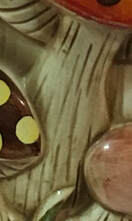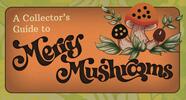|
Jack Buchanan tells the story that he got the idea for creating a kitchen coordinate line with mushrooms after stumbling on a patch of mushrooms in his backyard in Chicago, Illinois. But what could have been those fateful fungi? What did those real mushrooms look like? To find the answer, I turned to my fungi books. Besides hunting for Merry Mushrooms in thrift stores and rummage sales, I'm constantly on the lookout for real mushrooms around the neighborhood and in the woods. Not to clog this blog post with pictures of fungi, but look at all these varieties I've "collected" throughout southeastern and central Wisconsin! After spying them, I try to identify them. Not to eat, mind you, but because I appreciate the huge variety of delightful decomposers that tidy our outdoors. Identification is challenging not only because there are thousands of mushroom varieties, so many that some are simply lumped together (e.g. little brown mushrooms), and also because the appearance of mushrooms changes from day to day, and depending on environmental conditions (dry/wet, sunny/overcast, windy/calm). Applying the same technique of identifying wild mushrooms to Merry Mushrooms, I busted out my trusty Mushrooms of the Upper Midwest guide by Teresa Marrone and Kathy Yerich. Let's take a fun but, admittedly, very deep dive into an artistically rendered fungi!
Staying with the cap, let's consider the color and implied texture. The largest mushroom's cap has a differently colored center, a characteristic of older mushrooms, and the dark brown spots can be interpreted as patchy texture. The medium-sized, and younger, mushroom is solid color but shares the same spotted "texture." The smallest mushroom has a solid color cap and no spots, so perhaps the texture appears with age. Second is a look under the cap. Merry Mushrooms have widely spaced straight gills, and not sponge-like pores. It's hard to tell for sure, but it appears that the gills are free gills, meaning that they curve up into the cap, ending where the cap meets the stem. This means of attachment is opposed to the gills curving down and joining the stem below the cap.  Third is to examine the stem. Sears' famous fungi have a bulbous stem, meaning it appears to bulge at the base. Texture is also important to stems. Though the flat decal designs imply ridged or grooved stems, the grooves are readily seen, and felt, on the embossed pieces. Last is to create a spore print, which requires placing the mushroom on half black, half white paper. The spores fall onto the paper and their color aids in identification. Sadly, since Merry Mushrooms aren't real, the spore print is inconclusive. So, we have a lot of information, but are there any mushrooms that fit this profile?
The closest to the basic shape is a bolete mushroom, though they don't match any other characteristics. Another, better, possibility is oak collybia which matches shape and gills, and, though the stem isn't grooved, it is a little wider at the bottom. A third, and pretty close, choice is Big Laughing Gym. It has gills, a slightly bulbous and textured (not grooved, though) stem, and a sort of domed cap with texture and/or streaks. There are plenty of other possibilities, but these are the top three. Any mycophiles out there who want to weigh in?
Comments are closed.
|
AuthorWrite something about yourself. No need to be fancy, just an overview. Archives
October 2023
Categories
All
|
